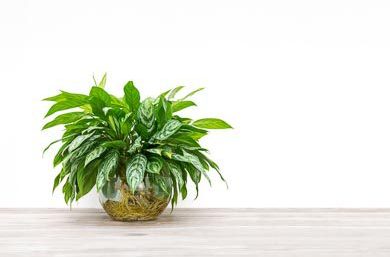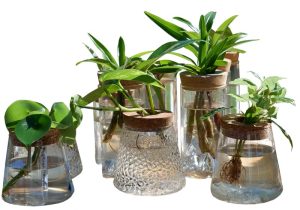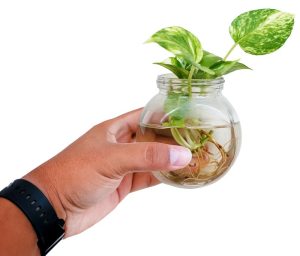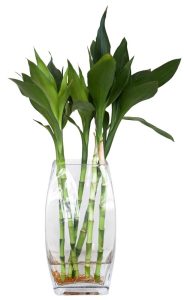
Hydroponic house plants
Several times a week I visit a Mandeville Street café, memorable for great coffee, fab food, and a biophilic wall of house plant cuttings growing in test tubes. By Lynda Papesch.
While travelling overseas recently, I also noticed a similar trend, with cafés, restaurants, and large multi-national hotels all growing house plants in decorated glass jars and vases. Some had hand-knitted coverings on the jars, others were decorated with fabric and bling, and others left unadorned. 
As someone who regularly forgets to water pot plants, I thought this a great idea so dived in to research tips and techniques. I’ve found it’s a no-fuss, mess-free, and decorative way to grow house plants in water. No messy soil to worry about, and so many colourful species to grow.
A wide variety of house plants thrive in a watery environment, and it is easy to make the containers look decorative, and to complement your interior design style. Once cuttings develop roots, they can be potted in soil, or transferred to larger containers. I have started mine in a medium size jar, with a few small, white pebbles on the bottom. Other options include various coloured stones, a layer of sand, or even marbles. 
Plants that grow in water need little care. Aside from keeping the water topped up, just add a weak organic fertiliser annually (maybe), and change the water occasionally to stop it becoming cloudy.
Remember that some plants like less sunlight than others, while yet others may enjoy direct sunlight. Growing plants in water is an easy way to propagate indoor plants including begonias, spider plants, and coleus. Once clipped and placed in water, the stems of many tropical plants produce roots.
It may take weeks or months but you can eventually transplant the rooted plants to a pot of soil or you can continue to enjoy them in water. Any vase, glass, jar, or bottle can be used, and plastic containers work well too.
TOP TIPS
1. Pick a plant that can be grown in water. Start with a fresh stem or leaf cutting, depending on the type of plant. Make sure your cutting has several leaves. Cut stems just below a leaf node.
2. Place the stem or leaf in fresh water. Use bottled, rain or tap water. If using tap water, allow it to stand for 24 hours before use so any chlorine can dissipate.
3. Move the container to a spot that offers bright, indirect light. Avoid heat source locations such as a fireplace, wood stove, heat pump, or radiator.
4. Top up the water as it evaporates and change it every few weeks or if it becomes cloudy. Occasionally add a few drops of liquid, organic fertiliser.
VASES come in all shapes, sizes, and colours. They can be glass, or made from pottery or another material. Just be sure they’re water-tight so you don’t have any leaks. For a single stem or two use a vase with a narrow neck to help keep the plant upright.
JARS are ideal and can be recycled for plant growing after they’ve been emptied and cleaned.
DRINKING GLASSES also come in a variety of sizes, shapes, and colours. Repurpose the sole survivor in a set, or set up three in a row.
TEST TUBES are one of the trendiest ways to display houseplants in water. The narrow tubes make excellent plant propagators when you are rooting cuttings in water or you can display a collection of single stems. Some tubes come with wooden stands, or glass bulb style. 
PLANT OPTIONS
Herbs such as basil, mint, rosemary, and oregano
Chinese evergreen (Aglaonema species)
Rubber plant (Ficus elastica)
Dieffenbachia species
Heartleaf philodendron (Philodendron hederaceum)
Golden Goddess philodendron
Golden pothos or devil’s ivy (Epipremnum aureum)
Lucky bamboo (Dracaena sanderiana)
Spider plant (Chlorophytum comosum)
Coleus (Solenostemon scutellarioides)
Begonia (Begonia species)
Sweet potato vine (Ipomoea batatas)
Geranium (Pelargonium species)
Wandering Jew (Tradescantia genus)
Peace Lily (Spathiphyllum genus)
Prayer plant (Maranta leuconeura)



